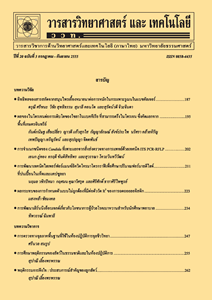Types of Guard Cell and Subsidiary Cell Variation of Wild and Some Cultivated Banana Stomata in Thailand to Indicate Genome Groups
Main Article Content
Abstract
Wild and cultivated bananas which are the member of genus Musa, family Musaceae have been classified to genome groups including AA, AAA, AAB, ABB, BBB and BB. The A and B genome consisting group are from M. acuminata and M. Balbisiana, respectively. Both of them are ancestor of cultivated bananas. All samples represented in different genome groups were thoroughly studied in the stomata type and the variation of subsidiary cell in order to determine their characteristics and to indicate to genome group. The results indicated that a type of all banana stomata were tetracytic type which included 4 subsidiary cells around the guard cells. The arrangement of the subsidiary cells causes the variation within types of stomata. Firstly, 2 subsidiary cells which were parallel with the guard cell had the cell length covered the other 2 subsidiary cells which were perpendicular to the guard cell. Secondly, all 4 subsidiary cells were valvate arrangement together. These variations of the subsidiary cells among different genome groups could be used for separation all samples into A and B genome group, especially in genome group of AA, AAA genomes, and subsequently BB and BBB genomes. In contrast, cultivated bananas in AAB and ABB genomes showed unclearly arrangement of the subsidiary cells in their genomes. Besides, the cultivated bananas, BB genome showed the longest guard cell, while that BBB genome, revealed the highest density of stomata.
Article Details
References
เบญจมาศ ศิลาย้อย, 2558, กล้วย, สำนักพิมพ์มหาวิทยาลัยเกษตรศาสตร์, กรุงเทพฯ, 512 น.
Simmonds, N.W. and Shepherd, K., 1955, The taxonomy and origins of the cultivated bananas, J. Linn. Soc. (Bot.) 55: 302-312.
Silayoi, B. and Babpraserth, C, 1983, Banana Genetic Resource Exploration in Thailand, Report Submitted to IBPGR, Kasetsart University, Bangkok.
กรมวิชาการเกษตร, 2561, กล้วยกินได้ของกรมวิชาการเกษตร, เกินคุ้ม มีเดีย, นนทบุรี, 240 น.
อภิชาติ ศรีสอาด และศุภวรรณ์ ใจแสน, 2556, สารพัดกล้วยยอดนิยม, สำนักพิมพ์นาคาอินเตอร์มีเดียร์ จำกัด, กรุงเทพฯ, 138 น.
Zarinkamar, F., 2007, Stomatal observa tions in dicotyledons, PJBS 10: 199-219.
พวงผกา สุนทรชัยนาคแสง, 2557, กายวิภาคและสัณฐานวิทยาของพืชมีดอก, สำนักพิมพ์ท้อปจำกัด, กรุงเทพฯ, 380 น.
ประศาสตร์ เกื้อมณี, 2551, เทคนิคเนื้อเยื่อพืช, สำนักพิมพ์มหาวิทยาลัยเกษตรศาสตร์, กรุงเทพฯ, 289 น.
Jain, K.K., 1976, Hydrogen peroxide and acetic acid for preparing epidermal peels from conifer leaves, Stain Technol. 51: 202-204.
Salisbury, E.J., 1928, On the causes and ecological significance of stomatal frequency, with special reference to the woodland flora, Trans. R. Soc. London B 216: 1-65.
ประวัติ สมเป็น, 2526, การศึกษาลักษณะสัณฐานบางประการของกล้วยที่มีจำนวนโครโมโซมต่างกัน, ปัญหาพิเศษปริญญาโท, ภาควิชาพืชสวน คณะเกษตร มหาวิทยาลัยเกษตรศาสตร์, กรุงเทพฯ, 42 น.
Simmonds, N.W., 1977, Bananas, In Evolution of crop plants, Longman, London.
เทียมใจ คมกฤส, 2549, กายวิภาคของพฤกษ์, สำนักพิมพ์มหาวิทยาลัยเกษตรศาสตร์, กรุงเทพฯ. 308 น.
Simmonds, N.W., 1986, Classification and breeding of the banana, In Proceedings of ACAIR.
Arjcharoen, A., Silayoi, B., Wanichkul, K., and Apisitwanich, S., 2010, Variation of B genome in Musa accessions and their new identifications, ANRES 44: 392-400.
ภาสันต์ ศาลทูลทัต, 2540, การชักนำให้กล้วยไข่กลายพันธุ์ในสภาพเพาะเลี้ยงเนื้อเยื่อด้วย colchicine และ oryzalin, วิทยานิพนธ์ปริญญาโท, มหาวิทยาลัยเกษตรศาสตร์, กรุงเทพฯ, 70 น.
Ravan, P.H., Berg L.R. and Hassenzahl, D.M, 2008, Environment, The McGraw-Hill, New York, 315 p.


